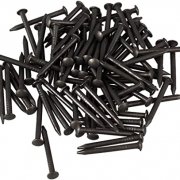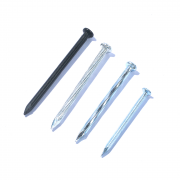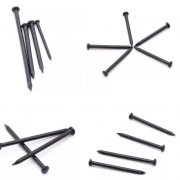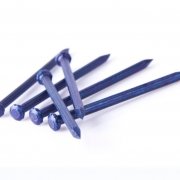What is concrete Nail
Concrete nails introduction is necessary for daily use.
A nail is usually of hardened steel for use in masonry. A concrete nail is a type of mechanical fastener. It is used to secure objects into masonry and other hard and brittle materials. Nailing into masonry requires the right type of nail, a good quality hammer, and some technique. Concrete nails are often used in building construction. Also wildly used in home improvement projects. Concrete steel nails are special fasteners and different than common iron nails.
Definition of concrete nails
Masonry drill bits can be used to bore holes into concrete walls. Cement nails, commonly known as steel nails, and concrete nails, are a kind of nails. They are made of high carbon steel and are made of 45-gauge steel or 60-gauge steel. They are processed by wire drawing, annealing, nail making, quenching, and other processes, so the texture is relatively hard. Its function is to nail it to some hard objects that other nails cannot nail, because the material is very different from ordinary nails, and it is a special nail. Cement nails are very hard, thick, short, and have a strong chiseling ability.

There are types of concrete nails
Heads of concrete nails have a round shape, provide a positive mechanical stop, and a surface for a hammer to be used to pound the nail into the material. Concrete nails are also available without a head.
- Galvanized concrete nails
- Color concrete nails
- Black concrete nails for Dubai, Uae
- Bluish concrete nails with various special nail heads and shank types
Concrete nails have a head on one end, and a cylindrical shaft that tapers to a sharp point at its other end, to help engage the nail by penetrating into the objects being fastened. And the cylindrical portion of the nail is known as the shank. The shank is what gives concrete nails a very firm holding strength. There are a variety of shank types available.
- Smooth shank
- Ring shank
- Twisted shank
- Twilled shank
- Spiral shank
- Angular spiral shank
- straight grooved shank
- twisted grooved shank
A twisted shank can give concrete nails a very firm holding strength. The shank is usually short, thick, and often ribbed to provide piercing and clenching strength. There are a variety of shank types available, including smooth, ring, twisted, and twilled. Especially, the twisted ribbed shanks provide surfaces that help to grip the concrete and reduce the chances that the nail will loosen and come out over time.
Dimensions of Concrete cement nails
Concrete nails have different diameters, lengths, and shank types to meet a wide variety of applications. As we know, the concrete nail is normally harder than a common iron nail. We use Galvanized concrete nails the most common type. Their raw materials are high-quality carbon steel and zinc-plated to provide strength and corrosion resistance.
Cement steel nails are used for the connection of light wood keels, hardwood, brick walls, and cement mortar components, the specifications are 16mm, 20mm, 25mm, 30mm, 40mm, 50mm, 60mm, 70mm, 80mm, 100mm, is with strong hardness and good toughness.
- 2*20mm
- 2*25mm
- 2*30mm
- 2.5*25mm
- 3*30mm
- 3*40mm
- 3.5*60mm
- 3.8*70mm
- 3.8*80mm
- 4.0*100mm
More details of concrete steel nails
| item | Concrete steel nails introduction |
| Shank Type | smooth, Spiral |
| Head Style | Flat, Mushroom |
| Place of Origin | China |
| City | Tianjin |
| Brand Name | BESTFOR |
| Model Number | 1/2”-6” |
| Type | Concrete Nail |
| Material | 45# concrete steel nails |
| Head Diameter | 7-8mm |
| Standard | DIN |
| Standard | ISO, JIS, DIN |
| Material | #45 steel |
| Diameter | 2.1-5mm |
| Length | 1/2”-6” |
| Surface treatment | electric zinc plated |
| Shank | plain/twisted/grooving shank |
| Processing | heat treatment, plate, salt spray test |
| System of measurement | inch, metric |
| Name | stainless steel nail/concrete nail supplier |
| keyword | stainless steel nail |
Meanwhile, Cement nails, also known as steel nails, are made of carbon steel, with high hardness, thick and short, and strong penetrating power. Cement nails are generally divided into black cement nails, blue cement nails, colored cement nails, and countersunk heads. Cement nails, K-shaped cement nails, T-shaped cement nails, and galvanized cement nails.
The types of nails include pattern nails, steel row nails, code nails, cement steel nails, wood screws, twist nails, splicing nails, self-tapping screws, shooting nails, staples, bolts, straight nails, special steel nails, and ordinary round nails Nails, shooting nails, floor nails, collar nails, concrete steel nails, decorative nails, the length of the nails selected should be 2.5 to 3 times the thickness of the nailed workpiece.

How to use concrete nails?
As we know concrete nails introduction is very important for us, so what is a concrete nail and how to use a concrete nail?
Concrete nails are most often used with a special power tool(Known as a Nail driver). It provides a strong hammering action to allow penetration of concrete. It provides a powerful hammering effect, driving the nail into the concrete in one stroke.
The advantages are:
- Penetrate the concrete quickly and effortlessly.
- Resulting in a stronger and more accurate
- mechanical connection.
Concrete nails can also be hammered by hand. Direct can be difficult to handle, easy to pin deflection. But don’t worry, we have a pilot hole, slightly smaller than the diameter of the nail. It is usually beforehand hammering nails drilled into the concrete. The pilot hole helps maintain the accuracy of the hole and reduces the force required to pound the nail.
Normally we use a hammer to hit concrete nails manually. It needs requires several blows with the hammer to fully sink the nail, and then results in reduced gripping strength and holding power. If have a drill will be better. Then these pilot holes, which are slightly smaller than the diameter of the nail, are usually drilled into the concrete before manually hammering the nail. Pilot holes help to maintain the accuracy of the hole and reduce the force needed to pound the nail in.
Concrete nails are most often used with special power tools called nail guns. The tool provides a powerful hammer action to penetrate the concrete. The nail gun can create a strong impact along the axis of the nail, driving the nail into the concrete at a time. Using a nailer improves the nail’s ability to penetrate concrete quickly and easily and produce a stronger, more accurate mechanical connection.
Safety Precautions:
Many DIYers use hand tools without hearing and eye protection. They believe that only power tools can guarantee this level of care. But any time you’re using a hammer or other impact tool, it’s best to use basic safety equipment. Hammers can easily snap nails — especially brittle hardened steel of concrete or masonry nails — and make them fly in the air. In some cases, the surface of the hammer may break and send the pieces flying. Prolonged exposure to the noise of drilling can damage hearing.
Always wear an anti-particle mask when drilling into concrete, as cement dust can damage the lungs.
Till here, we all know well about concrete nails introduction. Hope it can use in daily life.





